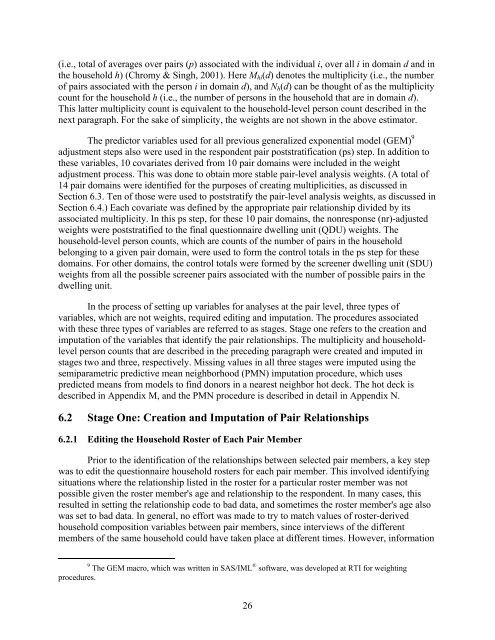Questionnaire Dwelling Unit-Level and Person Pair-Level Sampling ...
Questionnaire Dwelling Unit-Level and Person Pair-Level Sampling ...
Questionnaire Dwelling Unit-Level and Person Pair-Level Sampling ...
Create successful ePaper yourself
Turn your PDF publications into a flip-book with our unique Google optimized e-Paper software.
(i.e., total of averages over pairs (p) associated with the individual i, over all i in domain d <strong>and</strong> in<br />
the household h) (Chromy & Singh, 2001). Here M hi (d) denotes the multiplicity (i.e., the number<br />
of pairs associated with the person i in domain d), <strong>and</strong> N h (d) can be thought of as the multiplicity<br />
count for the household h (i.e., the number of persons in the household that are in domain d).<br />
This latter multiplicity count is equivalent to the household-level person count described in the<br />
next paragraph. For the sake of simplicity, the weights are not shown in the above estimator.<br />
The predictor variables used for all previous generalized exponential model (GEM) 9<br />
adjustment steps also were used in the respondent pair poststratification (ps) step. In addition to<br />
these variables, 10 covariates derived from 10 pair domains were included in the weight<br />
adjustment process. This was done to obtain more stable pair-level analysis weights. (A total of<br />
14 pair domains were identified for the purposes of creating multiplicities, as discussed in<br />
Section 6.3. Ten of those were used to poststratify the pair-level analysis weights, as discussed in<br />
Section 6.4.) Each covariate was defined by the appropriate pair relationship divided by its<br />
associated multiplicity. In this ps step, for these 10 pair domains, the nonresponse (nr)-adjusted<br />
weights were poststratified to the final questionnaire dwelling unit (QDU) weights. The<br />
household-level person counts, which are counts of the number of pairs in the household<br />
belonging to a given pair domain, were used to form the control totals in the ps step for these<br />
domains. For other domains, the control totals were formed by the screener dwelling unit (SDU)<br />
weights from all the possible screener pairs associated with the number of possible pairs in the<br />
dwelling unit.<br />
In the process of setting up variables for analyses at the pair level, three types of<br />
variables, which are not weights, required editing <strong>and</strong> imputation. The procedures associated<br />
with these three types of variables are referred to as stages. Stage one refers to the creation <strong>and</strong><br />
imputation of the variables that identify the pair relationships. The multiplicity <strong>and</strong> householdlevel<br />
person counts that are described in the preceding paragraph were created <strong>and</strong> imputed in<br />
stages two <strong>and</strong> three, respectively. Missing values in all three stages were imputed using the<br />
semiparametric predictive mean neighborhood (PMN) imputation procedure, which uses<br />
predicted means from models to find donors in a nearest neighbor hot deck. The hot deck is<br />
described in Appendix M, <strong>and</strong> the PMN procedure is described in detail in Appendix N.<br />
6.2 Stage One: Creation <strong>and</strong> Imputation of <strong>Pair</strong> Relationships<br />
6.2.1 Editing the Household Roster of Each <strong>Pair</strong> Member<br />
Prior to the identification of the relationships between selected pair members, a key step<br />
was to edit the questionnaire household rosters for each pair member. This involved identifying<br />
situations where the relationship listed in the roster for a particular roster member was not<br />
possible given the roster member's age <strong>and</strong> relationship to the respondent. In many cases, this<br />
resulted in setting the relationship code to bad data, <strong>and</strong> sometimes the roster member's age also<br />
was set to bad data. In general, no effort was made to try to match values of roster-derived<br />
household composition variables between pair members, since interviews of the different<br />
members of the same household could have taken place at different times. However, information<br />
9 The GEM macro, which was written in SAS/IML ® software, was developed at RTI for weighting<br />
procedures.<br />
26
















